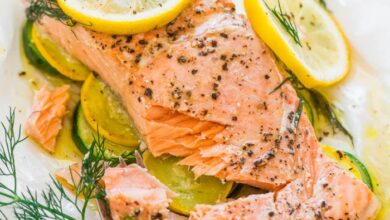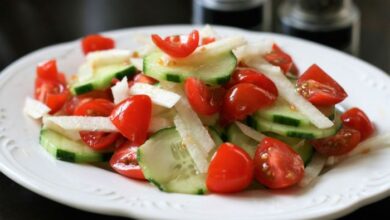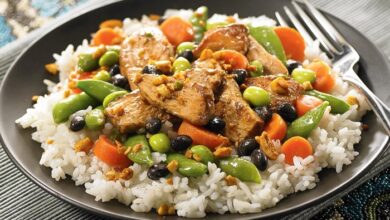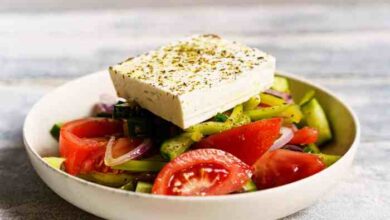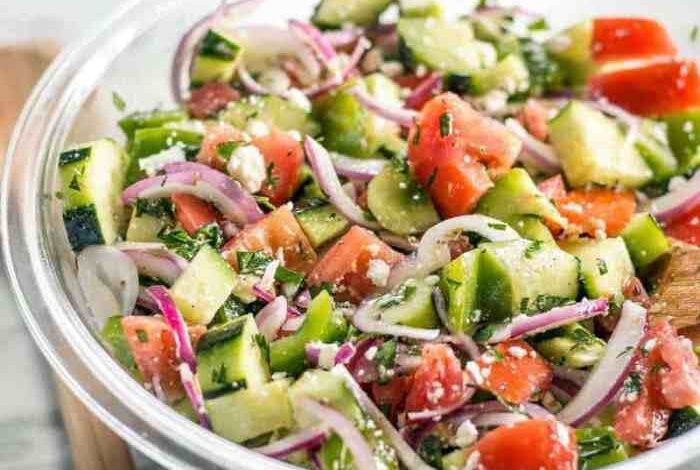
Cucumber Salads Around the World: A Global Culinary Adventure
Cucumber salads around world – Cucumber salads around the world, a simple yet versatile dish, offer a fascinating glimpse into diverse culinary traditions. From the refreshing crunch of a Greek tzatziki to the spicy kick of a Korean oi muchim, these salads showcase the creativity and ingenuity of cultures across the globe.
Each region boasts its own unique twist, utilizing local ingredients and flavor profiles to create dishes that are both satisfying and flavorful.
This journey through cucumber salads will explore the various ingredients, preparation techniques, and cultural significance behind these beloved dishes. We’ll delve into the historical roots, the symbolic meanings, and the health benefits associated with cucumber salads, discovering how this humble ingredient has become a culinary staple in kitchens worldwide.
Ingredients and Flavor Profiles: Cucumber Salads Around World

Cucumber salads, a refreshing and versatile dish, showcase the culinary creativity of different cultures around the world. The diverse ingredients and preparation methods create a fascinating spectrum of flavors and textures.
Cucumber Varieties
The type of cucumber used in a salad plays a crucial role in determining its texture and flavor. Some popular varieties include:
- English cucumbers: These cucumbers have a thinner skin and fewer seeds, making them ideal for salads. They have a mild, refreshing flavor and a crisp texture.
- Persian cucumbers: Also known as “mini cucumbers,” these cucumbers are small and have a delicate flavor with a slightly sweet note. They are often used in salads where their smaller size adds a visually appealing element.
- Japanese cucumbers: These cucumbers have a long, thin shape and a mild, slightly sweet flavor. They are often pickled or used in salads with a light dressing.
- Armenian cucumbers: These cucumbers have a thick skin and a slightly bitter flavor. They are often used in salads where their bitterness adds a unique dimension to the dish.
Herbs and Spices
Herbs and spices are essential ingredients in cucumber salads, adding complexity and depth to the flavor profile.
- Fresh herbs: Dill, mint, parsley, and cilantro are commonly used to add freshness and aroma.
- Spices: Cumin, coriander, and turmeric are sometimes used to create more complex flavor profiles.
- Other ingredients: Onions, garlic, and ginger can be added to enhance the flavor and create a more robust salad.
Flavor Profiles
The flavor profiles of cucumber salads vary widely depending on the ingredients and preparation methods.
| Region | Common Ingredients | Flavor Profile |
|---|---|---|
| Middle East | Cucumber, tomato, onion, lemon juice, olive oil, dill, mint | Fresh, tangy, and slightly sweet |
| Mediterranean | Cucumber, feta cheese, olives, red onion, oregano, lemon juice, olive oil | Salty, tangy, and herbaceous |
| Asia | Cucumber, sesame oil, soy sauce, ginger, garlic, chili peppers | Savory, umami, and spicy |
| North America | Cucumber, sour cream, dill, salt, pepper | Creamy, tangy, and refreshing |
Cultural Significance and Traditions
Cucumber salads, with their refreshing simplicity and versatility, have woven themselves into the fabric of culinary traditions across the globe. They are not just a dish; they are a reflection of history, cultural identity, and the art of using readily available ingredients to create flavorful meals.
Cucumber Salads in Traditional Cuisines
Cucumber salads are a staple in many traditional cuisines, reflecting the diverse ways cultures have embraced this versatile ingredient.
- In Mediterranean cuisine, cucumber salads are a mainstay, often featuring ingredients like tomatoes, onions, feta cheese, and a drizzle of olive oil. These salads are enjoyed as a light and refreshing starter or side dish, perfectly complementing grilled meats and seafood.
- In Asian cuisine, cucumber salads often incorporate a tangy and spicy element, with ingredients like vinegar, chili peppers, and sesame oil. Examples include the Korean Oi Muchim, a spicy cucumber salad with gochujang, and the Vietnamese Gỏi Dưa Leo, a refreshing cucumber salad with fish sauce and lime juice.
- In Indian cuisine, cucumber salads are often part of elaborate meals, featuring a blend of spices and herbs. The Kachumber salad, a popular Indian salad, combines cucumbers with tomatoes, onions, cilantro, and a tangy dressing.
Cucumber Salads in Cultural Events
Cucumber salads are not only a part of everyday meals but also play a significant role in various cultural events and celebrations.
- In Middle Eastern countries, cucumber salads are often served during Ramadan, the Muslim holy month of fasting. The salads are a refreshing and hydrating way to break the fast during the evening meal, known as Iftar.
- In Southeast Asia, cucumber salads are often featured at weddings and other celebrations. Their refreshing taste and vibrant colors symbolize good luck and prosperity. For example, in Thailand, a popular wedding dish is Yam Tua Phu, a spicy cucumber salad with peanuts and shrimp.
- In Central Europe, cucumber salads are a staple at summer picnics and outdoor gatherings. The salads are a refreshing and light way to enjoy the warm weather and celebrate the season.
Historical Significance of Cucumber Salads
The history of cucumber salads can be traced back to ancient civilizations, where cucumbers were valued for their refreshing and cooling properties.
- In ancient Egypt, cucumbers were a common food and were believed to have medicinal properties. They were often used in salads and other dishes to combat the heat and thirst of the desert climate. Evidence suggests that cucumbers were cultivated in Egypt as early as 2000 BC.
- In ancient Greece, cucumbers were also a popular food, and they were often used in salads and other dishes. The Greeks believed that cucumbers could help to improve digestion and relieve headaches.
- In ancient Rome, cucumbers were a popular food and were often used in salads and other dishes. The Romans also believed that cucumbers could help to improve digestion and relieve headaches.
Symbolic Meanings of Cucumber Salads
Cucumber salads hold symbolic meanings in different cultures, reflecting the deep-rooted connection between food and cultural identity.
- In Chinese culture, cucumbers symbolize purity and freshness, and they are often used in salads and other dishes to represent a clean and healthy start. The green colorof cucumbers is also associated with good luck and prosperity.
- In Japanese culture, cucumbers are associated with longevity and good health. They are often used in salads and other dishes to celebrate special occasions and to wish for a long and healthy life.
- In Indian culture, cucumbers are associated with coolness and refreshment, and they are often used in salads and other dishes to help people cope with the hot weather.
Health Benefits and Nutritional Value
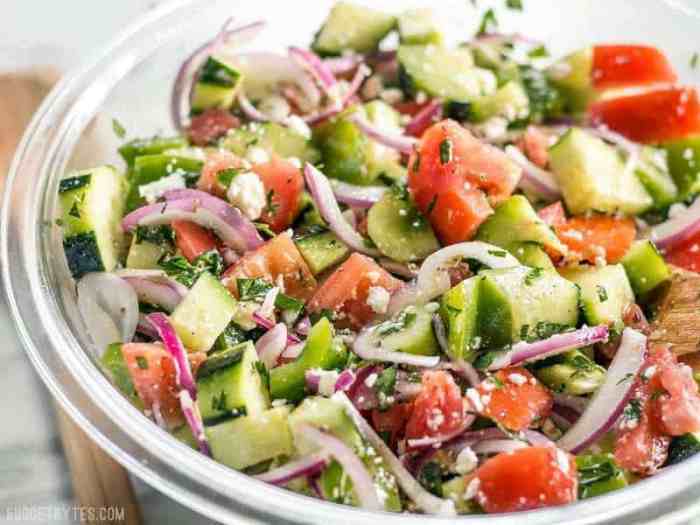
Cucumber salads are not only delicious and refreshing but also a nutritious addition to any meal. Cucumbers are low in calories and rich in essential vitamins, minerals, and antioxidants, making them a valuable component of a healthy diet.
Nutritional Composition of Cucumbers, Cucumber salads around world
Cucumbers are primarily composed of water, making them a hydrating food. They also contain a modest amount of fiber, which aids in digestion and promotes a feeling of fullness. Here are some key nutrients found in cucumbers:
- Vitamin K:Essential for blood clotting and bone health.
- Vitamin C:An antioxidant that supports immune function and collagen production.
- Potassium:An electrolyte that helps regulate blood pressure and muscle function.
- Magnesium:Important for muscle and nerve function, as well as energy production.
- Silicon:A mineral that contributes to bone health and connective tissue strength.
Health Benefits of Cucumber Salads
The nutritional content of cucumbers and the various ingredients commonly used in cucumber salads contribute to several potential health benefits:
Hydration
Cucumbers are approximately 96% water, making them an excellent source of hydration. Staying hydrated is crucial for overall health and well-being, as it supports various bodily functions, including digestion, circulation, and temperature regulation.
Digestive Health
The fiber in cucumbers can promote regular bowel movements and aid in digestion. It can also help prevent constipation and promote a healthy gut microbiome.
Blood Sugar Control
Cucumbers have a low glycemic index, meaning they do not cause rapid spikes in blood sugar levels. This makes them a suitable food for individuals with diabetes or those looking to manage their blood sugar.
Antioxidant Properties
Cucumbers contain antioxidants, such as flavonoids and tannins, which can help protect cells from damage caused by free radicals. Antioxidants may contribute to reducing the risk of chronic diseases, such as heart disease and cancer.
Blood Pressure Regulation
Cucumbers are a good source of potassium, which is known to help regulate blood pressure. Maintaining healthy blood pressure is crucial for cardiovascular health.
Skin Health
Cucumbers are often used topically for their skin-soothing properties. They contain silica, which may help improve skin elasticity and reduce wrinkles.
Additional Nutritional Value from Salad Ingredients
The ingredients used in cucumber salads can further enhance their nutritional value. For example, adding tomatoes, onions, bell peppers, and herbs can provide additional vitamins, minerals, and antioxidants. For example, tomatoes are rich in lycopene, a powerful antioxidant that has been linked to a reduced risk of certain cancers.
Onions contain quercetin, another antioxidant with anti-inflammatory properties. Bell peppers are a good source of vitamin C, and herbs like parsley and dill contribute to the overall flavor and nutritional profile of the salad.
Culinary Applications and Serving Suggestions
Cucumber salads are a versatile and refreshing addition to a wide array of culinary experiences, from light and healthy lunches to elaborate dinner parties. Their crisp texture and cool, refreshing flavor make them a perfect complement to various cuisines and dishes.
Cucumber Salad Applications
Cucumber salads can be incorporated into different culinary contexts, adding a unique touch to meals and elevating the overall dining experience.
- Appetizers:Cucumber salads serve as light and refreshing appetizers, particularly during warm weather. They can be served with dips like hummus, tzatziki, or yogurt-based dressings.
- Side Dishes:They are a popular side dish for grilled meats, fish, and poultry, offering a contrasting cool and refreshing element to heavier main courses.
- Salads:Cucumber salads can be incorporated into larger salads, adding a crunchy texture and refreshing flavor. They can be combined with other vegetables, fruits, and grains to create a balanced and flavorful salad.
- Sandwiches and Wraps:Cucumber salads can be used as fillings for sandwiches and wraps, adding a refreshing and crunchy element to these popular lunch options.
- Soups and Stews:Cucumber salads can be added to cold soups and stews, providing a contrasting texture and refreshing flavor.
Creative Cucumber Salad Recipes
The versatility of cucumber salads allows for endless possibilities in terms of flavor profiles and ingredients. Here are some creative and flavorful cucumber salad recipes:
- Classic Cucumber Salad with Dill and Yogurt:This simple and refreshing salad combines thinly sliced cucumbers with fresh dill, red onion, and a creamy yogurt dressing. It is a classic choice for a light and flavorful side dish.
- Spicy Cucumber Salad with Ginger and Chili:This recipe adds a spicy kick to the traditional cucumber salad with the inclusion of ginger, chili flakes, and a tangy lime dressing. It is perfect for those who enjoy a bit of heat in their food.
- Cucumber and Tomato Salad with Balsamic Vinaigrette:This salad combines the refreshing flavors of cucumber and tomato with a tangy balsamic vinaigrette. The sweetness of the tomatoes complements the refreshing flavor of the cucumber, creating a balanced and delicious salad.
- Cucumber and Avocado Salad with Lemon-Lime Dressing:This salad combines the creamy texture of avocado with the refreshing flavor of cucumber and a zesty lemon-lime dressing. It is a light and flavorful salad that is perfect for a summer lunch.
- Cucumber and Watermelon Salad with Mint and Feta:This refreshing salad combines the sweetness of watermelon with the cool flavor of cucumber and the tangy flavor of feta cheese. It is a perfect summer salad that is both flavorful and visually appealing.
Pairing Suggestions
Cucumber salads pair well with a variety of dishes and beverages, enhancing the overall dining experience.
- Main Courses:Cucumber salads are a perfect complement to grilled meats, fish, and poultry, offering a refreshing contrast to heavier flavors. They also pair well with vegetarian dishes, such as tofu stir-fries and lentil stews.
- Side Dishes:Cucumber salads can be served alongside other side dishes, such as rice, quinoa, or couscous, adding a refreshing element to the meal.
- Beverages:Cucumber salads pair well with light and refreshing beverages, such as iced tea, lemonade, or sparkling water. They also complement alcoholic beverages, such as white wine, rosé, and cocktails.

